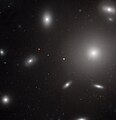Fail:NGC 4874 HST.jpg

Selle eelvaate suurus: 578 × 600 pikslit. Teised eraldusvõimed: 231 × 240 pikslit | 463 × 480 pikslit | 740 × 768 pikslit | 987 × 1024 pikslit | 1973 × 2048 pikslit | 3864 × 4010 pikslit.
Algfail (3864 × 4010 pikslit, faili suurus: 5,95 MB, MIME tüüp: image/jpeg)
Faili ajalugu
Klõpsa kuupäeva ja kellaaega, et näha sel ajahetkel kasutusel olnud failiversiooni.
| Kuupäev/kellaaeg | Pisipilt | Mõõtmed | Kasutaja | Kommentaar | |
|---|---|---|---|---|---|
| viimane | 20. september 2011, kell 14:55 |  | 3864 × 4010 (5,95 MB) | Jmencisom |
Faili kasutus
Seda faili kasutab järgmine lehekülg:
Globaalne failikasutus
Järgmised muud vikid kasutavad seda faili:
- Faili kasutus vikis ar.wikipedia.org
- Faili kasutus vikis arz.wikipedia.org
- Faili kasutus vikis ast.wikipedia.org
- Faili kasutus vikis az.wikipedia.org
- Faili kasutus vikis be.wikipedia.org
- Faili kasutus vikis ce.wikipedia.org
- Faili kasutus vikis cs.wikipedia.org
- Faili kasutus vikis de.wikipedia.org
- Faili kasutus vikis diq.wikipedia.org
- Faili kasutus vikis en.wikipedia.org
- Faili kasutus vikis eu.wikipedia.org
- Faili kasutus vikis fr.wikipedia.org
- Faili kasutus vikis hr.wikipedia.org
- Faili kasutus vikis it.wikipedia.org
- Faili kasutus vikis ja.wikipedia.org
- Faili kasutus vikis kk.wikipedia.org
- Faili kasutus vikis ko.wikipedia.org
- Faili kasutus vikis mk.wikipedia.org
- Faili kasutus vikis nl.wikipedia.org
- Faili kasutus vikis pl.wikipedia.org
- Faili kasutus vikis ru.wikipedia.org
- Faili kasutus vikis sk.wikipedia.org
- Faili kasutus vikis sl.wikipedia.org
- Faili kasutus vikis tt.wikipedia.org
- Faili kasutus vikis uk.wikipedia.org
- Faili kasutus vikis uz.wikipedia.org
- Faili kasutus vikis www.wikidata.org
- Faili kasutus vikis zh.wikipedia.org